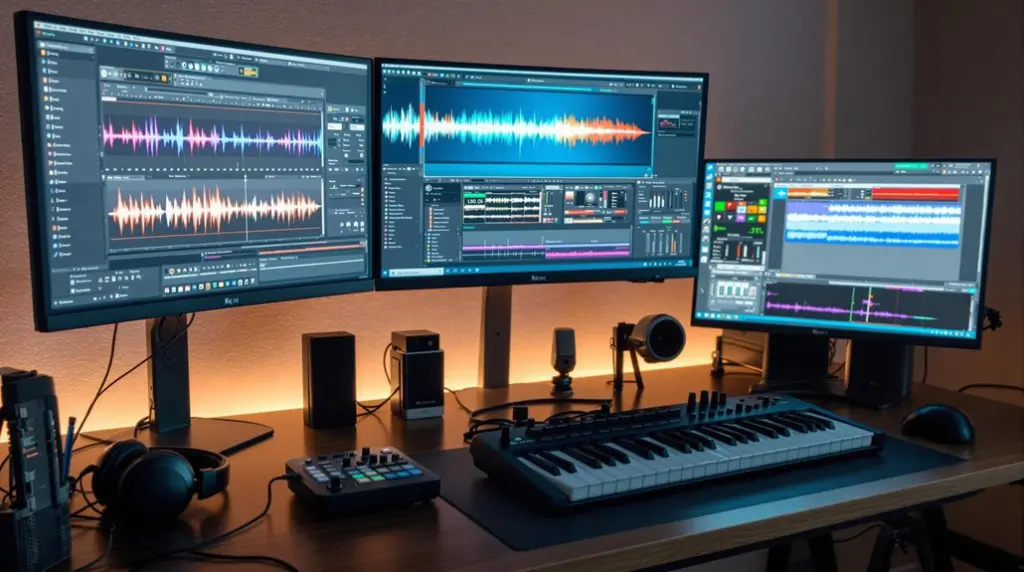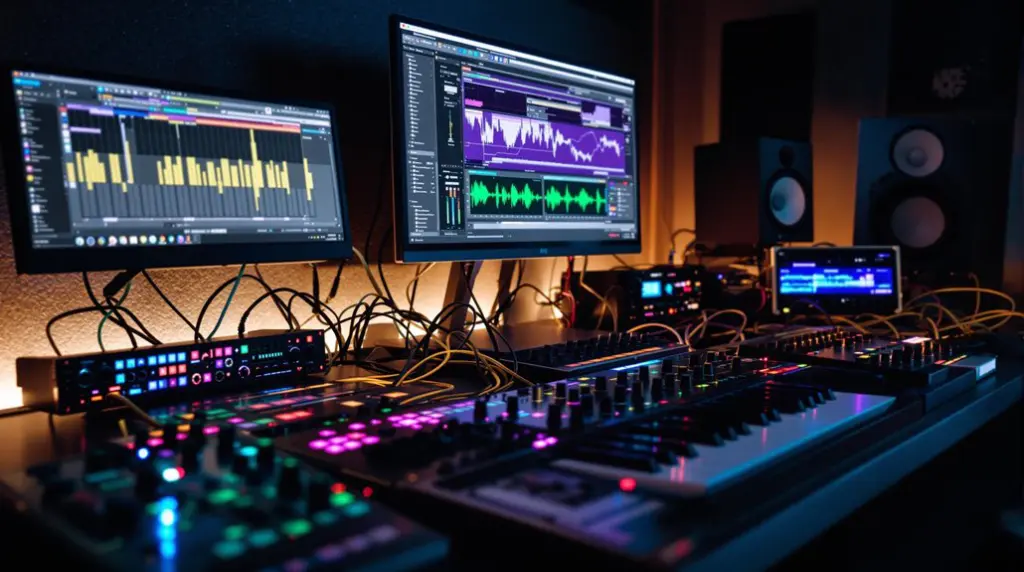The Korg MS-20 synthesizer, a modern recreation of the iconic 1978 model, offers a semi-modular design, dual voltage-controlled oscillators (VCOs), and both 12dB/oct low-pass and 6dB/oct high-pass resonant filters. The compact yet durable build retains the original’s tactile, angled panel, and the three-quarter size keyboard enhances portability without compromising sound quality. Its robust patch bay supports extensive modulation, while external processing capabilities and MIDI/USB connectivity expand its integration options. Although it lacks MIDI output and features smaller keys, the authentic analog sound and affordability make it a compelling choice for both novices and seasoned musicians alike. Discover additional features that distinguish this synthesizer in further detail.
Key Takeaways
- Dual VCOs with four waveforms and self-oscillation capabilities for diverse sound creation.
- Compact, 86% size of the original, enhancing portability and usability for live performances.
- Dual resonant filters, including Korg35 design, for rich, overdriven tones.
- Semi-modular design with patch bay supports extensive sound manipulation and external signal routing.
- Affordable price around $599 makes analogue synthesis accessible for beginners.
Overview and Historical Context
The Korg MS-20 Mini, a modern recreation of the iconic Korg MS-20 synthesizer, draws its legacy from the original model released in 1978. This initial release became renowned for its modular patch bay and distinctive sound characteristics, making a significant mark in synthesizer history.
Often referred to as a “poor man’s Moog,” the original MS-20 provided an affordable yet powerful alternative to more expensive counterparts. Priced around $599, the MS-20 Mini is approximately 85% the size of the original, incorporating a smaller keyboard and 1/8-inch jacks instead of the original 1/4-inch jacks.
The historical significance of the MS-20 is amplified by its semi-modular design, which allows for versatile sound creation and control. This design makes it compatible with both analog sequencers and modular synthesizers, exemplifying an analog revival in electronic music.
The continued popularity of the MS-20 Mini underscores a resurgent interest in analog synthesis techniques, reflecting a broader trend in the music industry towards vintage equipment. The MS-20, much like the strategies employed by record labels to enhance production quality, has become an essential tool for artists aiming to refine their sound.
Collectors and musicians alike are drawn to its distinctive sound and historical legacy, solidifying its status as a cornerstone in the evolution of electronic music synthesis.
Design and Build Quality
The Korg MS-20 Mini’s compact, 86% scaled design enhances portability, making it ideal for live performances without compromising the iconic look of its predecessor.
Its durable metal chassis, paired with plastic side panels, strikes a balance between robustness and lightweight handling.
However, while the three-quarter size keyboard offers improved playability, the smaller dials’ sideward play may impact precision in sound adjustments, presenting a minor compromise in design integrity.
Compact and Portable Design
Korg’s MS-20 Mini presents a meticulously engineered compact and portable design, which is a scaled-down version at approximately 86% of the original MS-20’s size. This reduction in size considerably enhances performance portability, making it an ideal travel-friendly synth for musicians on the go.
The MS-20 Mini maintains the robust sonic capabilities of its predecessor while fitting into a more manageable form factor. The construction quality of the MS-20 Mini features a metal chassis with durable plastic ends, guaranteeing longevity and a lightweight profile.
This combination fosters a balance between sturdiness and portability, essential for live performances and frequent travel. The modern surface mount components contribute to a clean internal layout, enhancing reliability and ease of use.
Key aspects of the MS-20 Mini’s design include:
- Compact size: 86% of the original, ideal for transport.
- Solid construction: Metal chassis with durable plastic ends.
- Three-quarter size keyboard: Improved playability.
- Modern components: Clean internal layout for enhanced reliability.
- Build quality: Despite smaller dials with sideward play, overall robust design.
The MS-20 Mini’s design guarantees that it meets contemporary needs while preserving the classic feel, making it a versatile tool for musicians seeking a reliable, portable analog synthesizer.
Nostalgic Visual Appeal
With its nostalgic visual appeal, the MS-20 Mini masterfully balances retro aesthetics with modern engineering. Approximately 86% the size of the original MS-20, this compact design not only enhances portability but also retains the vintage charm that made its predecessor iconic.
The sturdy metal chassis combined with durable plastic end panels guarantees the MS-20 Mini can withstand the rigors of travel, making it an ideal choice for live performances.
The three-quarter size keyboard offers improved playability, addressing the limitations of the original model and enhancing the user experience. This modification maintains the authentic feel while providing a more comfortable interface for musicians.
The inclusion of smaller dials, despite exhibiting sideward play, adds to the nostalgic aesthetics, evoking the tactile experience of the original MS-20.
Internally, the MS-20 Mini incorporates modern surface mount components, guaranteeing reliability and performance stability.
The clean layout preserves the iconic angled panel design, an homage to the original model’s distinctive look. This thoughtful blend of vintage charm and contemporary build quality not only appeals to seasoned synthesizer enthusiasts but also attracts a new generation of musicians seeking a reliable and visually appealing instrument.
Sound Generation Capabilities
The Korg MS-20 Mini’s sound generation capabilities are anchored by its dual voltage-controlled oscillators, offering four waveforms that facilitate a broad spectrum of sonic outputs, from robust basses to piercing leads.
The incorporation of Korg35 filters, with distinctive 6dB/oct high-pass and 12dB/oct low-pass configurations, allows for intricate sound shaping, including the possibility of overdriven resonance for self-oscillation effects.
Additionally, the extensive modulation options, such as the low-frequency oscillator and sample and hold generator, provide advanced tools for crafting complex and textured sounds.
Dual Oscillator System
Boasting a robust dual-oscillator system, the Korg MS-20 Mini delivers extensive sound generation capabilities that cater to both traditional and experimental sound design.
At the core of this system are two voltage-controlled oscillators (VCOs) that offer four distinct waveform options—sawtooth, square, triangle, and noise. This variety in waveform selection provides a broad palette for sound creation, from deep bass tones to bright leads and abstract soundscapes.
The first oscillator can produce footages ranging from 32 to 4, while the second oscillator covers a range from 16 to 2. This wide range in oscillator tuning allows for intricate layering of sounds and complex harmonic structures.
Additionally, the oscillators can be modulated by the built-in low-frequency oscillator (LFO), injecting dynamic movement into the generated sounds.
Key features include:
- Four waveform options: Sawtooth, square, triangle, and noise.
- Wide tuning range: First oscillator (32 to 4), second oscillator (16 to 2).
- LFO modulation: Adds dynamic movement to sounds.
- Self-oscillation characteristics: Unique tonal shaping and resonance effects.
- Complex sound design: Capable of producing everything from bass to experimental soundscapes.
The dual oscillator system in the Korg MS-20 Mini exemplifies versatility and precision in analog sound synthesis.
Filter Versatility
A hallmark of the Korg MS-20 Mini’s design, its filter versatility greatly enhances its sound generation capabilities. At the core of this versatility are the dual resonant filters: a 12dB/oct low-pass and a 6dB/oct high-pass. These filters allow for extensive sound shaping, providing a palette of tonal possibilities. The unit’s unique Korg35 filter design stands out, capable of producing overdriven tones and self-oscillation, contributing rich, creamy sounds and effective wah-style effects.
Additionally, the MS-20 Mini supports multiple filter modes, including notch and band-reject, which expand its tonal range further. This flexibility is pivotal for sound design, enabling users to craft everything from subtle textures to aggressive sonic landscapes. The filter resonance is remarkably strong, making it ideal for creating pronounced basslines and leads.
The MS-20 Mini also excels in external processing. Its patch bay allows users to route external signals through its filters, thereby expanding its utility beyond internal sound sources. This feature is particularly beneficial for processing sounds from other instruments.
| Filter Type | Slope (dB/oct) | Unique Features |
|---|---|---|
| Low-Pass Filter | 12 | Korg35 design, self-oscillation |
| High-Pass Filter | 6 | Korg35 design, strong resonance |
| Notch/Band-Reject | Variable | Multiple filter modes |
Modulation Options
Endless modulation possibilities lie at the heart of the Korg MS-20 Mini’s sound generation capabilities. This synthesizer is equipped with a diverse array of modulation tools that allow for sophisticated sound design and extensive creative exploration.
A single LFO (Low-Frequency Oscillator) generates both triangular and pulse waves, providing rich modulation options for oscillator pitch and filter cutoff frequencies. The MS-20 Mini also features two contour generators: EG1 (trapezoidal) and EG2 (HADSR). These contour generators enable precise modulation of various parameters, including oscillator pitches and audio VCA/filter cutoff frequencies, adding depth and complexity to sound sculpting.
Key modulation features include:
- LFO capabilities: Triangular and pulse waves for versatile modulation.
- Contour generators: EG1 and EG2 for intricate control over sound parameters.
- Patch bay: Extensive signal routing options for creating complex modulation paths.
- Sample hold: Random modulation of parameters for unpredictable, creative effects.
- Dual oscillators: Enable unique modulation effects and enhanced sound design potential.
The patch bay is particularly significant, offering extensive signal routing options that empower users to craft intricate modulation paths.
The integration of a sample hold (S&H) generator further augments the MS-20 Mini’s modulation arsenal, enabling random parameter modulation to produce innovative and dynamic sounds.
Modulation and Control Features
While the Korg MS-20 Mini may appear straightforward at first glance, its modulation and control features reveal a depth of complexity that is essential for serious sound design. Central to this complexity are the two contour generators, EG1 and EG2, which provide sophisticated envelope shaping capabilities. EG1 operates as a trapezoid envelope generator, while EG2 employs a HADSR (Hold, Attack, Decay, Sustain, Release) configuration, granting precise control over audio VCA and filter cutoff frequencies.
The single LFO (Low-Frequency Oscillator) further enhances sound design with its triangular and pulse waves, enabling intricate LFO modulation of oscillator pitches and filter cutoff. Despite minor calibration discrepancies between the original MS-20 and the Mini, this feature remains a powerful tool for modulation.
The patch bay system is a standout, allowing for extensive signal routing. This physical patching system connects five facilities, including the Sample and Hold (S&H) generator and External Signal Processor (ESP), fostering real-time manipulation and sound experimentation.
| Feature | Description | Benefit |
|---|---|---|
| EG1 | Trapezoid envelope generator | Precise envelope shaping |
| EG2 | HADSR envelope generator | Control over VCA and filter cutoff |
| LFO | Triangular and pulse waves | LFO modulation of pitch and filter |
| Patch Bay | Connects multiple sound modules | Extensive signal routing |
| Real-time Manipulation | Dynamic control of parameters | Enhanced sound experimentation |
These features collectively make the MS-20 Mini a versatile and powerful tool for any sound designer.
Connectivity and Integration
Connectivity and integration are essential aspects of the Korg MS-20 Mini, greatly enhancing its versatility and usability in modern setups. The synthesizer features both MIDI DIN and USB connections, allowing for fundamental note sequencing and MIDI communication.
However, it’s important to note the MIDI limitations; the MS-20 Mini recognizes only Note On/Off messages on Channel 1, which restricts its MIDI functionality compared to more sophisticated synthesizers that support a broader range of modulation messages.
The synth employs Hertz-per-volt analog control voltage for pitch control, aligning it with vintage Korg equipment but rendering it incompatible with the volts-per-octave systems prevalent in Eurorack setups. This specific integration aspect may require users to invest in additional converters for seamless operation with more modern modular systems.
A significant highlight is the inclusion of a patch bay with 1/8-inch jacks. This feature provides wide-ranging sound routing possibilities and facilitates integration with other modular synths or external audio sources.
Additionally, the MS-20 Mini serves as a basic MIDI to CV and Gate converter, enhancing its connectivity with older analog gear.
Key points include:
- Basic MIDI DIN and USB connectivity
- MIDI limitations with only Note On/Off messages on Channel 1
- Hertz-per-volt pitch control system
- Extensive patch bay with 1/8-inch jacks
- Functionality as a MIDI to CV and Gate converter
User Experience and Playability
The user experience of the Korg MS-20 Mini is defined by its thoughtful design and intuitive interface, offering a synthesis journey that appeals to both novices and seasoned musicians. The three-quarter size keyboard greatly enhances playability, making the instrument accessible regardless of the user’s keyboard proficiency.
User feedback highlights the MS-20 Mini’s excellent pitch stability and tracking, which guarantees performance consistency during live sessions, a critical aspect for professional use. The MS-20 Mini is also praised for its compatibility with various essential music production gear.
The springy keyboard feel, coupled with highly responsive knobs, provides an engaging and tactile experience that encourages hands-on exploration of synthesis. Users particularly appreciate the inclusion of minijack patch cords, which facilitate immediate interaction with the synthesizer’s various features, setting it apart from more sterile digital synthesizers.
However, some user feedback points to limited octave accuracy issues. Despite this, the overall playability remains commendable, especially when the MS-20 Mini is paired with full-sized keyboards.
These design choices collectively create a user-friendly and reliable instrument, making the MS-20 Mini a versatile addition to any synthesist’s toolkit. The balance of intuitive design and performance consistency underscores its enduring appeal in the music production landscape.
Pros and Cons
Despite its compact size, the Korg MS-20 Mini excels in delivering an authentic analogue sound reproduction, which is fundamental for creating rich and versatile tones suited for basslines and leads. This makes it a highly desirable instrument for both novice and experienced sound designers.
Its portability and affordability, with a price point around $599, further enhance its appeal as an entry-level analogue synthesizer. However, the MS-20 Mini comes with its share of limitations that can affect the user experience.
It is also important to take into account the dynamic range preservation when using this synthesizer, as maintaining expressive nuances is vital for achieving the desired emotional impact.
Pros:
- Authentic analogue sound reproduction, providing rich and versatile tones.
- Compact and portable design, making it convenient for on-the-go musicians.
- Affordable price point, making it accessible for those new to analogue synthesis.
- Semi-modular architecture, offering extensive patching possibilities for sound design.
- Classic design, retaining the look and feel of the original MS-20.
Cons:
- Lack of MIDI output, which limits integration into modern, complex setups.
- Mini keys, which may impact playability for users accustomed to full-sized keys.
- Smaller output jack, which can be less versatile compared to standard jacks.
- Limited built-in presets, potentially restricting immediate sound design options.
- Somewhat dated interface, which may not align with the expectations of contemporary users.
Frequently Asked Questions
Does the Korg MS-20 Have a Sequencer?
The Korg MS-20 lacks built-in sequencer functionality, focusing instead on real-time sound manipulation. Users can achieve pattern creation by using external MIDI or analog sequencers, leveraging the synthesizer’s CV/Gate inputs for complex control.
Is Korg MS-20 Polyphonic?
The Korg MS-20 is not polyphonic; it is a monophonic synthesizer. Despite its monophonic nature, it excels in synthesis techniques and sound design, providing intricate control over bass lines and leads through its semi-modular architecture.
What Is the History of Korg Ms-20?
The Korg MS-20, a cornerstone of Korg’s legacy in analog synthesis, debuted in 1978. Initially an affordable alternative to Moog synthesizers, its semi-modular design and unique sound later cemented its status as a highly sought-after instrument.
Does Korg MS-20 Mini Have Midi?
Yes, the Korg MS-20 Mini features MIDI functionality through a MIDI DIN connection and USB port. Despite its compact design, it only supports basic Note On/Off messages on Channel 1, limiting extensive MIDI control without additional equipment.
Conclusion
The Korg MS-20 synthesizer presents a robust, historically significant instrument characterized by its durable design and versatile sound generation capabilities. Its extensive modulation and control features, along with thorough connectivity options, make it a valuable tool for both studio and live performance environments. Despite some limitations in user interface complexity, the MS-20 delivers a unique and rich sonic palette, reinforcing its position as a seminal device in the domain of analog synthesizers.




